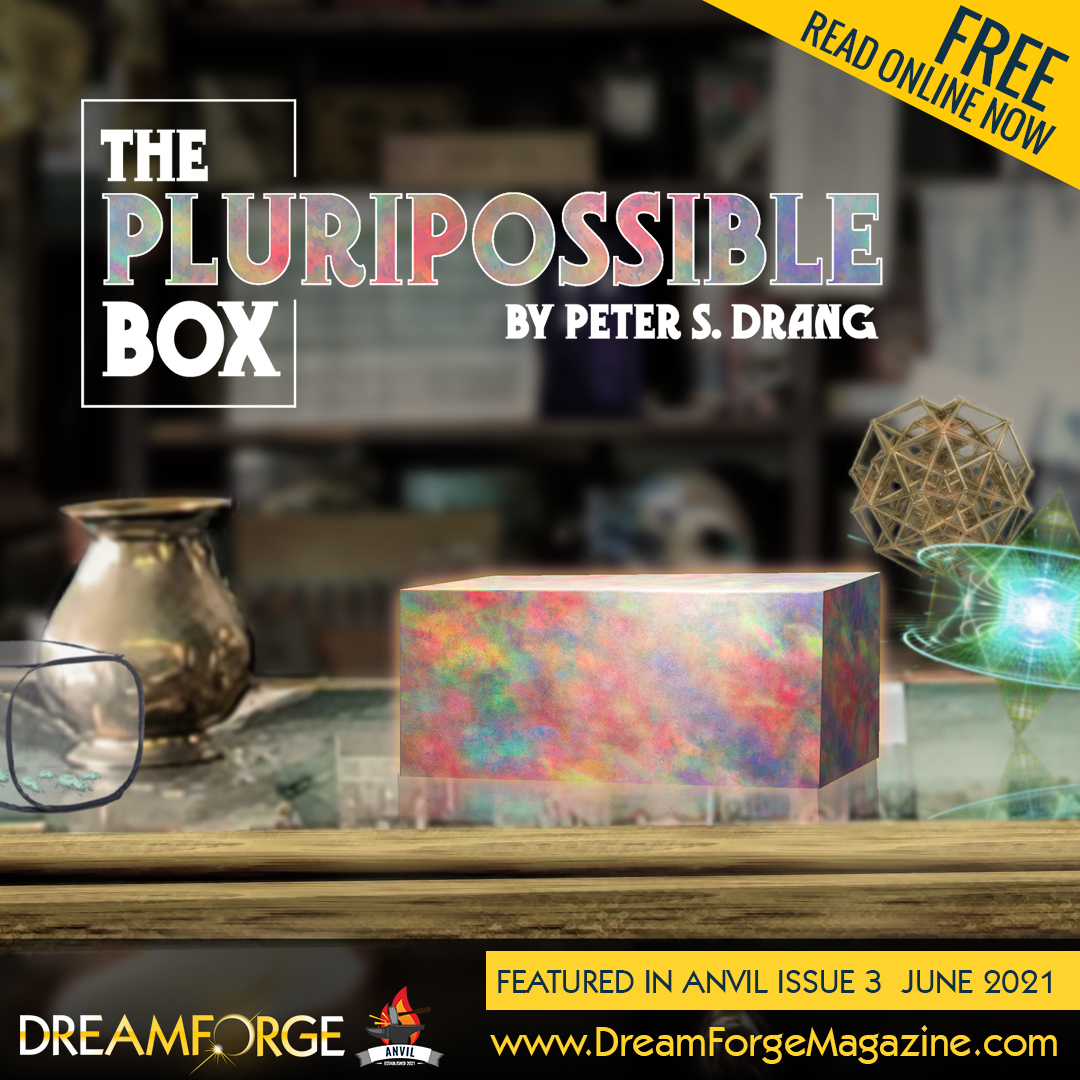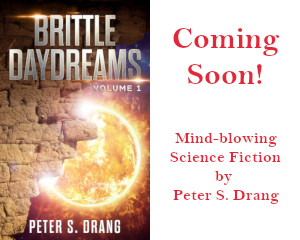“The Pluripossible Box“, (Science Fiction, about 3,500 words) one of my stories, dropped today on the great fiction site Dreamforge Anvil. In this article I provide notes on this tale of alien artifacts and the power of love.
The story is currently free to read on Dreamforge. They publish optimistic science fiction and fantasy stories. Dreamforge operates on a voluntary subscription basis and they’re a magazine well worthy your patronage. Your subscription unlocks additional content.
I was amazed by the illustrations by artist Jane Noel (the image at the top of this article is one example her work), I think they perfectly captured what I had in my “mind’s eye” while writing the story.
WARNING: There are some minor spoilers in this article, so before continuing past this point please take the fifteen or so minutes required to read this short story: Click Here to read “The Pluripossible Box” on the Dreamforge website.
Story Origins
The idea for this story came from a family outing. My wife and two young sons attended a magic show. The two magicians would occassionally point at a box hanging from the ceiling, and then would sing the words “What’s in the box?” At the very end of the show, they brought the box down and spilled it on a table. It contained small items owned by audience members, items that had disappeared during the show.
About twenty years later, in 2019, I sat down to write a story, with no ideas in mind. For some reason I thought of that magic show, and realized that a simple, repeated question could build suspense. I wrote the line: “What’s in this box?” and took it from there, completing the first draft in a single sitting that lasted about three hours.
Theme
The theme of this story is simple: “What’s in the box?” That question drives just about every aspect of the plot. After I wrote the first line, I pretty quickly decided to take that concept to its logical conclusion: The box could hold anything imaginable that could possibly fit inside. I quickly realized that would make it very powerful and even dangerous.
At first I thought writing about a box like that might require magic (making this a fantasy story) but realized that 3d printers have something akin to that capability today. I amped up what current printers could do, of course, and added a multitude of alien artifacts to make the world where such a thing could exist more believable. This made the story science fiction. Part of the fun of writing the story came from thinking of weird alien devices and alien races like the Glaktons.
Arthur C. Clark famously said, “Any sufficiently advanced technology is indistinguishable from magic,” and that applies here. I could have really chosen either SF or fantasy. I had just written a couple of fantasy stories, though, and went the other way.
What Does it Mean?
My standard disclaimer applies: it means anything the reader thinks it means. Often I am delighted by the interpretations readers have of my stories, and I’ve even changed my opinion on what my own story means to me after hearing other viewpoints! So, the rest of this section is just what was rolling around in my head as I was writing, but that doesn’t mean other interpretations are not equally valid.
The main character is a lonely widow who haunts the many alien artifact shops that have sprung up since interdimensional portals started opening some years earlier.
Her personal struggle with her feelings of loss for her beloved husband Ed support the theme because her life is empty without him, she’s searching through alien artifact shops to try to fill the void he left. The parallel is: she’s like the box in that since her husband’s death she doesn’t know what’s inside herself anymore. Her pursuit to find out what’s inside the box parallels her pursuit to find out what’s inside herself.
This of course comes back to tie it all together at the end: Ed was always the cautious one in the relationship, she was always the adventurous one. While she helped get him out of ruts caused by his stifling caution, his steady personality sometimes helped her get out of jams that her “fools rushing in” adventurism caused. This dynamic foreshadows the ending. At the end, her love for him was the sole factor that saved her life.
To me, the box represents the endless possibilities that life has to offer, if only you knew what to pursue, or in this case, what to ask for. The concept that the potential is more valuable than any particular realized content is also one that intrigued many of the early reviewers of this story. To me the message is: your life has infinite potential, and it’s up to you to choose how that potential is realized. It may take hard work, it may take some luck, and there may be many obstacles in your path, but the potential is still there.
The power of love to triumph over despair is also wrapped up in the ending. The box could have held diamonds or gold or powerful weapons, but none of those would have saved her. In the end, the key to escaping doom was to ask the box to contain a simple sentimental object from the main character’s past, one she longed to possess again.
This happy conclusion was perfect for the submission call for Dreamforge Anvil. They were looking for optimistic, hopeful speculative fiction. I immediately thought of this story, which had been languishing in slushpiles during the entire very un-hopeful un-optimistic Covid year of 2020.
I don’t write a lot of fiction with such unabashedly happy endings, but it was good to have one in inventory when the right market came along!
Timeline
Here’s the full publication timeline for this story.
- Draft started September 2019
- Workshop comments integrated by mid September
- From September 2019 through December, 2020: Story was submitted and declined by five pro markets (Asimov’s, Clarksworld, Interzone, Deep Magic, Analog). Several of these included encouraging comments.
- Submitted to Dreamforge Anvil on April 3, 2021. Accepted April 23. No revisions requested. Contract signed April 27.
- Published online 6/13/2021
Total calendar time: twenty months from start of first draft to contract, then a couple more months to publication.
Total actual writing time was around 10 to 12 hours including all edits and revisions.
Conclusion
This story was inspired by a family outing, and is an example of using everyday life experiences to generate ideas. It’s also a good example of the advantages of writing a variety of kinds of story. Some horrifying, some intellectual, some pessimistic, some tragic, and some, like this one, hopeful and optimistic. That gives you as a writer a diversified inventory with stories to match any thematic call for submissions that may pop up.
See also: “Gator and the Big Buzz” Accepted by FFO
See also: Turning Everyday Life into Science Fiction Story Ideas



